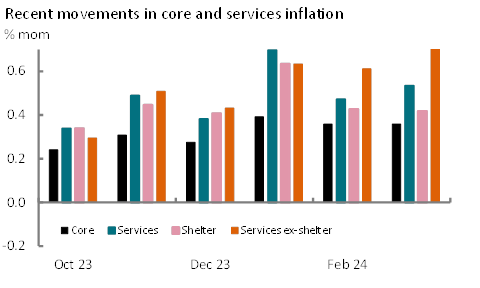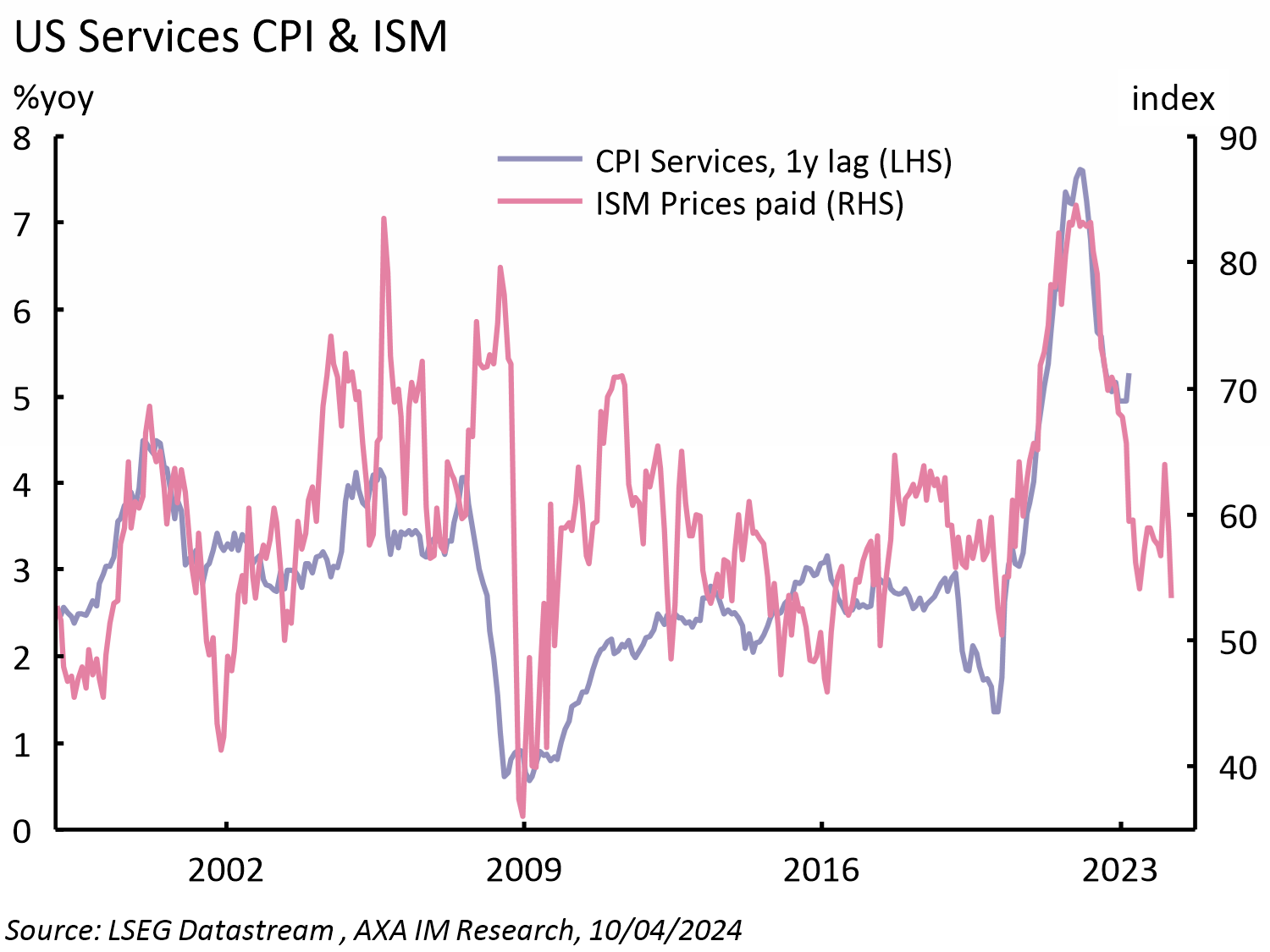
US reaction: Core CPI strength leads to shift in rate outlook
- 10 April 2024 (3 min read)
March’s CPI inflation posted another surprise to the upside. The headline rate rose on the month by 0.4%, taking the annual rate up to 3.5% - its highest rate in six months. While food prices remained reasonably benign, rising by just 0.1% on the month, energy prices were firm with motor fuel prices rising by 1.6% on the month and household energy services up 0.7%.
Yet it was developments in core prices that were the most troubling. Core inflation, excluding food & energy, also rose by 0.4% on the month, leaving the annual rate unchanged at 3.8%. The 0.359% rise was very much in line with February’s rise, but above market expectations for a 0.3% rise. While only marginally higher overall, it is services inflation that is causing the most concern (Exhibit 1). Services posted a 0.53% rise, faster than the 0.47% in February (albeit below the 0.7% January). Within that, shelter inflation was broadly unchanged, rising by 0.42% the same as the average pace for each of the last 9 months, barring January’s rogue reading. We still expect to see deceleration in this component over the coming months give the drop in housing costs seen across last year, but this is proving slower to materialize than expected.
However, services ex-shelter posted their fastest increase in 18-months, up 0.84% underpinning a steady acceleration in the 3-month annualized rate to 7.4%. While previous strength had been attributed to more volatile components including airfares, in March airfares fell by 0.4% on the month. Strength was rather recorded across a range of other indicators, including healthcare, where hospital services and health insurance both rose by 1.2%, transport services which rose by 1.5%, driven mainly by vehicle maintenance costs and motor insurance and miscellaneous services costs. In short there was a range of services costs that contributed to drive the monthly rate higher, something more suggestive of a tight labour market and elevated wages feeding through into broader pricing.
Medium-term indicators of services inflation still point to marked deceleration in services inflation ahead, including the prices paid component of the services ISM index which fell to its lowest level since the pandemic (Exhibit 2). However, this is not materializing yet. This is both a surprise to us and a challenge to the Federal Reserve’s outlook. While Fed Chair Powell was happy to dismiss January and February’s strength as bumps along the road, he reiterated that the Fed required further evidence to suggest that inflation was continuing to fall to target. Today’s figures have not delivered that and while we expect to see a softening in services ahead, the Fed is likely to require more than two softer report before it gains sufficient confidence. We have expected the Fed to begin to ease its restrictive stance in June since October, but now we push back our expectation for the first cut to July. We had also been expecting to see weaker growth see the Fed quicken the pace of rate cuts towards the end of this year. Although we still await Q1 GDP, we see firmer momentum for now and as such we remove this expectation. This leaves us expecting the Fed to cut rates to a range of 4.50-4.75% by year end and 3.75-4.00% by end 2025. However, we acknowledge that risks to this outlook are for later and fewer cuts still.
Markets reflected this shift. Where markets had been increasingly seeing the chance that the Fed could move later than Jun util today’s release, there was a clear switch to now suggesting that it would likely move later than June. The market had priced a 60% chance of a June rate cut before the release, it now prices just 25% and below 50% chance that the Fed moves in July, now only fully pricing a move by September and envisaging two cuts overall. 2-year and 10-year yields jumped sharply accordingly, 2-year US Treasury yields up 25bp to 4.97% and 10-year up 16bps to 4.51%. The dollar also rose sharply by 0.8% on the release.
Exhibit 1: Developments in core inflation

Source: BLS, April 2024
Exhibit 2: Services ISM points to further services disinflation

Related articles
View all articles

Causes and FX
- by Gilles Moëc
- 29 April 2024 (10 min read)

April Op-Ed - Looking outside the West
- by Gilles Moëc, Chris Iggo
- 26 April 2024 (10 min read)

Japan reaction: Cautious stance from the BoJ
- by
- 26 April 2024 (3 min read)
Disclaimer
This document is for informational purposes only and does not constitute investment research or financial analysis relating to transactions in financial instruments as per MIF Directive (2014/65/EU), nor does it constitute on the part of AXA Investment Managers or its affiliated companies an offer to buy or sell any investments, products or services, and should not be considered as solicitation or investment, legal or tax advice, a recommendation for an investment strategy or a personalized recommendation to buy or sell securities.
It has been established on the basis of data, projections, forecasts, anticipations and hypothesis which are subjective. Its analysis and conclusions are the expression of an opinion, based on available data at a specific date.
All information in this document is established on data made public by official providers of economic and market statistics. AXA Investment Managers disclaims any and all liability relating to a decision based on or for reliance on this document. All exhibits included in this document, unless stated otherwise, are as of the publication date of this document.
Furthermore, due to the subjective nature of these opinions and analysis, these data, projections, forecasts, anticipations, hypothesis, etc. are not necessary used or followed by AXA IM’s portfolio management teams or its affiliates, who may act based on their own opinions. Any reproduction of this information, in whole or in part is, unless otherwise authorised by AXA IM, prohibited.
Issued in the UK by AXA Investment Managers UK Limited, which is authorised and regulated by the Financial Conduct Authority in the UK. Registered in England and Wales No: 01431068. Registered Office: 22 Bishopsgate London EC2N 4BQ
In other jurisdictions, this document is issued by AXA Investment Managers SA’s affiliates in those countries.
© AXA Investment Managers 2024. All rights reserved
Risk Warning
The value of investments, and the income from them, can fall as well as rise and investors may not get back the amount originally invested.

